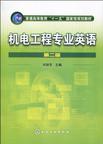机电工程专业英语
出版时间:2010-7 出版社:化学工业出版社 作者:宋瑞苓 编 页数:214
前言
本书第一版是根据全国高职高专专门课开发指导委员会确定的机电工程专业课程体系中的“机电工程专业英语”课程基本要求编写的,其出版发行六年以来因其专业针对性强,覆盖面广受到广大师生的好评。但是作为教材,其内容特点必须与时俱进。应出版社要求,编者做了局部的修订。 本教材在修订编写时,有以下几个方面的特点。 (1)保留原教材专业针对性强的特点:修订版保留了原书中机械电子技术的基本内容:工程材料、机械零件、切削机床、液压传动、电子线路、模数转换、接口技术、可编程控制器和数控技术等。 (2)更新近年来发展比较快的新技术内容:如快速成型技术、互联网技术、光刻复印技术、电子商务模式等,即便是相同的内容,取材也选自更新的国外原版教材及论文。 (3)增加现代管理一章:考虑到现代科技与管理学的密切联系,选编了组织管理、机构优势、市场计划、广告功能等,扩大学生视野,增长人文知识。 (4)取消较为难懂的篇目,如并行设计、软件工程等,增加了与日常生活有关的互联网应用、网上购物等,降低了课程难度,增加了学习的趣味性。 (5)排版风格独特:本书采用外国教材常用的旁注方式,理解难点随课文旁注,增加了阅读的方便性。
内容概要
本书共分为8章,内容包括制造导论、机械工程基础、机械制造技术、电子及控制技术、数控技术、数控操作、现代制造技术、现代管理和互联网及应用等,每章含有课文正文、生词词组、难点注释、理解练习、阅读材料等部分,各章节内容上彼此独立,难度上循序渐进。 本书内容新颖,覆盖面广,且有一定的专业针对性和实用性。 本书的教学资料:包括PPT教学课件,词汇测试系统等,是教师教学和学生学习的好帮手,并将免费提供给采用本书作为教材的院校使用。如有需要,请发电子邮件至cipedu@163.com 获取,或登录www.cipedu.com.cn免费下载。 本书可作为高职高专机械、机电、数控、工业工程及相关专业的教材,也可供工程技术人员参考。
书籍目录
Chapter One Fundamentals of Mechanical Engineering Lesson 1 Properties of Materials Reading Metals and Alloys Lesson 2 Classification of Steels Reading Machinability of Metals Lesson 3 Heat Treatment Reading Materials Used for Shafting Lesson 4 Types of Gear Reading Cams Lesson 5 Rolling-Type (Antifriction) Bearings Reading Clutch, Rack and Worm Chapter Two Technique of Manufacturing Engineering Lesson 1 Mechanism of Chip Formation Reading Cutting Fluids and Their Importance Lesson 2 Engine Lathe Reading Lathe Work Lesson 3 The Hydraulic System Reading Hydraulic Pumps Lesson 4 Electric Discharge Machining Reading Laser Beam Machining Lesson 5 Benefits of A Quality System Reading Introduction to ISO 9000 Basics Chapter Three Electronics Technology And Automation Lesson 1 Types of Integrated Circuits Reading Optoelectronics Lesson 2 Printed Circuit Reading Repair of Printed Circuit Lesson 3 Alternating-Current Motors Reading Motor& Motor Care and Maintenance Lesson 4 Interfacing Reading A/D&D/A Converter Lesson 5 Controllers Reading Guidelines for Designing a PLC System Chapter Four CNC Machines Lesson 1 The Fundamentals of CNC Reading The Concepts of Computer Numerical Control Lesson 2 Types of CNC Machines Reading Laser Cutting Lesson 3 The CNC Control Reading Components of CNC Machine Lesson 4 Methods for CNC Programming Reading Manual Programming Lesson 5 CAD/CAM Reading CAD/ CAM Integration Chapter Five CNC Machine Operating Lesson 1 Explanation of the Keyboard Reading FANUC—BESK NC System Lesson 2 Tilting NC-Rotary table Reading Employment Opportunities in NC Lesson 3 Handling and Operation Reading Chart Lesson 4 Failures and Breakdowns Reading Position Detectors- Opto-Electronical Rotary Encoders Lesson 5 Service and Maintenance Reading Error Search and Repair Chapter Six Modern Manufacturing Technology Lesson 1 Flexible Manufacturing Systems Reading Robotics Lesson 2 Expert Systems Reading Decision Support Systems Lesson 3 Computer Aided Process Planning Reading Artificial Intelligence & Expert System Lesson 4 Rapid Prototyping and Freeform Fabrication Reading Stereolithography Lesson 5 From the Present to the Future Reading Aesthetics in Design Chapter Seven Modern Management Chapter Eight Computer and Application References
章节摘录
Thus the cooling properties of cutting fluid depend to a large extent on thecooling method. The cooling efficiency increases with heat conductivity and specificheat of the cutting fluid, with its heat of fusion and of vaporization, and also with itsviscosity. Cooling effect increases, too, with the flow rate of the fluid, the area ofapplication and with decreasing temperature of the cutting fluid. The lubricating action of the cutting fluid reduces the external friction betweenrake face and chip and between flank and machined surface~. Effectiveness of thelubricating action depends, therefore, in the first place on the degree of penetration ofthe coolant between those surfaces. It follows from the magnitude of specific cuttingforces that very often, i.e. when machining steel, pressures between chip and toolpoint and between workpiece and tool point may reach 20000~30000 kg/cm2. Notwithstanding such high pressures, the use of suitable cutting fluids results in thereduction of friction and wear. The washing action of a cutting fluid consists in removing the products ofabrasion, chip fragments and tool wear particle. In practice, cutting fluids exhibitgood washing properties having high wettability and because particles immersed inthe liquid move downstream. This action has an advantageous influence on the smoothness of the machinedsurface and on the reduction of tool point wear. Surface loosening action of the cutting fluid, also called the cutting action of thisfluid, results from the so-called Rebinder effect. Adsorbed molecules of cutting fluid,particularly of liquids containing surface-active additives, disintegrate, diffuse andpenetrate into microgaps resulting from defects in the crystal lattice. Because of thewedge-like action of the adsorbed liquid, a very thin surface layer of the machinedmaterial becomes "loosened". According to Rebinders research, the thickness of this layer may reach 0.1 mm.Since the machined surface in the next pass becomes the work surface, plasticdeformation appearing in the chip formation area and slip of the chip elements occurmore easily and more frequently. This phenomenon is called internal lubrication. The efficiency of activated liquids increases with a reduction in unreformedchip thickness, since in this case the percentage share of the thickness of loosed layer is greater in relation to the total thickness. Increasing the cutting speed decreases the efficiency of activated liquids. This is due to a more ductile chip, having a much smaller number of larger gaps of all sorts (lack of preceding gap and of built-up edge). Consequently, much fewer local vacuum spots are formed and the liquid does not penetrate everywhere, and dry friction may result.
图书封面
评论、评分、阅读与下载
